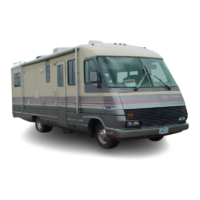20
Discovery, Discovery LXE, Pace Arrow, and Pace Arrow LXEt
IMPORTANT SAFETY
TIP:
Turn on the hazard lights if
road speed decreases to the
point where the motorhome
is moving significantly
under the posted speed.
Use pullouts if traffic is
accumulating. Once in a
pullout, if there is sufficient
clearance for safety, idle the
engine for a while to allow
the exhaust and the turbo
to cool. While these are
cooling, the transmission
will also cool. Continually
monitor the gauges while
waiting.
Descending a
Grade:
Prepare
to descend a
grade at the crest of
the hill. Observe
any signs indicating grade angle
and duration. The sign may
suggest maximum downhill speed
according to Gross Combined
Weight (the combined weight
of the motorhome and a trailer/
tow car). At the crest of the hill,
manually shift the transmission
into a lower gear. Do not allow the
motorhome to gain momentum
before slowing down.
Use the engine brake to help
maintain a slow, safe downhill
speed. With the engine brake
applied, road speed may still
increase and the transmission may
automatically shift to the next
higher gear. Apply the brakes using
moderately heavy pressure on the
brake pedal to reduce speed then
manually downshift to maintain a
safe, slow speed. Do not pump the
brakes. This can result in a loss of
air pressure. Riding the brakes can
cause the brakes to overheat. Either
method can result in loss of brake
effectiveness or even brake failure.
Night Driving:
Be well rested and alert.
If necessary, nd a safe to
stop and rest until ready to
continue.
Avoid using interior lights
that create a glare on the
windshield and decrease
visibility.
Dim dash lights to a
comfortable level to reduce
glare.
Extreme Heat/Hot Weather
Conditions:
Frequently observe all
gauges. Variations from
normal conditions should
be promptly evaluated.
Check tire pressure before
traveling in hot conditions.
Tire air pressure increases
with heat. Do not let air out
of a hot tire. When the tires
cool down they will return
to the correct/previous tire
pressure.
Pay extra attention to hoses
and belts that are more
susceptible to fatigue in
extreme heat.
Winter and Cold Climate:
The motorhome should be
prepared for cold weather
use.
Keep speeds slow and
steady. Make moves
gradually and look further
ahead to increase reaction
distance.
Air pressure in the tires
decrease in cold weather.
Check tires and ensure
tires are at proper ination
pressure.
If road or weather
conditions are treacherous,
nd a safe place to stop
until conditions improve.
Avoid downshifting or
using the engine brake on
wet or slippery surfaces
that can cause the drive
wheels to skid.
Wiper blades should be
in good condition. Fill
the washer reservoir with
antifreeze
formula window
washer uid.
Use mirror heat
to keep mirrors
clear.
Remove any ice
build-up from
the entry step to
avoid accidental slipping.
Wet Conditions:
Worn or improperly inated
tires can increase risk of
hydroplaning.
Heavy rain or deep standing
water can cause brakes to
apply unevenly or grab.
Refueling:
Truck stops are good
refueling points.
Check overhead clearance
before pulling into the fuel
island.
Be aware of concrete/steel
posts installed around fuel
islands.
020181d
080574d
MIRROR
HEAT

